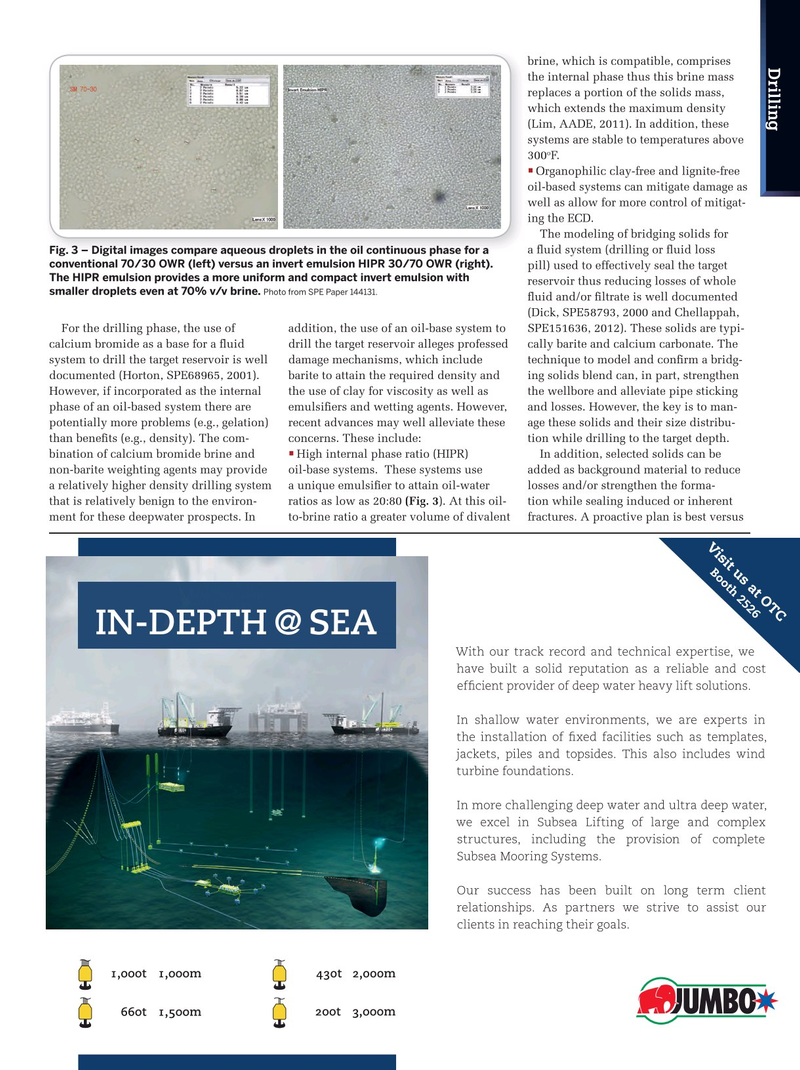
Page 57: of Offshore Engineer Magazine (May/Jun 2015)
Read this page in Pdf, Flash or Html5 edition of May/Jun 2015 Offshore Engineer Magazine
brine, which is compatible, comprises
Drilling the internal phase thus this brine mass replaces a portion of the solids mass, which extends the maximum density (Lim, AADE, 2011). In addition, these systems are stable to temperatures above o 300 F.
Organophilic clay-free and lignite-free • oil-based systems can mitigate damage as well as allow for more control of mitigat- ing the ECD.
The modeling of bridging solids for a ? uid system (drilling or ? uid loss
Fig. 3 – Digital images compare aqueous droplets in the oil continuous phase for a conventional 70/30 OWR (left) versus an invert emulsion HIPR 30/70 OWR (right). pill) used to effectively seal the target
The HIPR emulsion provides a more uniform and compact invert emulsion with reservoir thus reducing losses of whole smaller droplets even at 70% v/v brine. Photo from SPE Paper 144131. ? uid and/or ? ltrate is well documented (Dick, SPE58793, 2000 and Chellappah,
For the drilling phase, the use of addition, the use of an oil-base system to SPE151636, 2012). These solids are typi- calcium bromide as a base for a ? uid drill the target reservoir alleges professed cally barite and calcium carbonate. The system to drill the target reservoir is well damage mechanisms, which include technique to model and con? rm a bridg- documented (Horton, SPE68965, 2001). barite to attain the required density and ing solids blend can, in part, strengthen
However, if incorporated as the internal the use of clay for viscosity as well as the wellbore and alleviate pipe sticking phase of an oil-based system there are emulsi? ers and wetting agents. However, and losses. However, the key is to man- potentially more problems (e.g., gelation) recent advances may well alleviate these age these solids and their size distribu- than bene? ts (e.g., density). The com- concerns. These include: tion while drilling to the target depth. • bination of calcium bromide brine and High internal phase ratio (HIPR) In addition, selected solids can be non-barite weighting agents may provide oil-base systems. These systems use added as background material to reduce a relatively higher density drilling system a unique emulsi? er to attain oil-water losses and/or strengthen the forma- that is relatively benign to the environ- ratios as low as 20:80 (Fig. 3). At this oil- tion while sealing induced or inherent ment for these deepwater prospects. In to-brine ratio a greater volume of divalent fractures. A proactive plan is best versus
Visit us at OTC
Booth 2526
With our track record and technical expertise, we have built a solid reputation as a reliable and cost ef?cient provider of deep water heavy lift solutions.
In shallow water environments, we are experts in the installation of ?xed facilities such as templates, jackets, piles and topsides. This also includes wind turbine foundations.
In more challenging deep water and ultra deep water, we excel in Subsea Lifting of large and complex structures, including the provision of complete
Subsea Mooring Systems.
Our success has been built on long term client relationships. As partners we strive to assist our clients in reaching their goals. 056_OE0515_D&C2_TexasBrine.indd 59 4/20/15 6:34 PM 414-Adv-Jumbo-210x148.indd 1 14-04-15 11:49

 56
56

 58
58